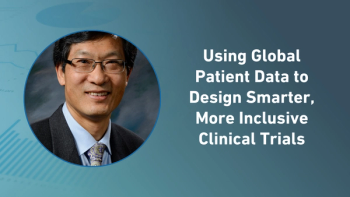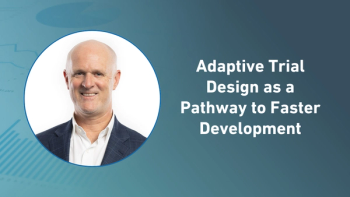
Role of Healthcare Providers Expands in DCTs
Portable imaging technology presents yet another opportunity for decentralized trials.
Even before the COVID pandemic, most clinical trials already had decentralized components such as blood draws completed at locations other than the designated trial site. However, the pandemic created an opportunity for a new decentralized component, telemedicine, with remote visits. Inexpensive telecommunication platforms, immensely popular in ordinary life, became very successful in routine healthcare, as evidenced by the massive increase in telemedicine claims during the pandemic. Telehealth claim lines increased 2980% in the US from September 2019 to September 2020, according to FAIR Health's Monthly Telehealth Regional Tracker.
Telemedicine use in research also increased during the same period in hybrid decentralized and fully decentralized clinical trials (DCTs). DCTs used software and devices to manage nearly all aspects of consent data collection, patient engagement, authentication, and data verification. These changes were made possible by regulatory bodies including the FDA, EMA, and MHRA, which provided guidance to investigators to maintain patient safety, data quality and trial integrity. The other component of DCTs is the contribution of mobile/local healthcare providers (HCPs) to their execution. HCPs may offer a way for prospective trial participants to take part in many trials regardless of trial duration; frequency of visits; disease state; distance to the investigative site; and travel plans.
In this article, we highlight a technological advance in portable imaging that could further increase the scope of DCTs, but is it really feasible to keep adding technical responsibilities to the role of mobile/local healthcare providers working in a decentralized trial environment?
Not all clinical trials benefit from DCTs
Phase I studies that require frequent interventions, such as dose modifications remain best suited for traditional settings. Until now, the same could be said of studies that require serial imaging of deep structures and/or serial tissue biopsies. This restriction might go away with the development of portable devices that can provide precise images of deep structures that lend themselves to clinical grading.
Current mobile HCP role
As per the Clinical Trials Transformation Initiative (CTTI) recommendation, the “activities that mobile HCPs may be able to perform include clinical assessments, blood draws, IMP or treatment administration, participant education, and in-home compliance checks.”The recommendation does not include acquisition of imaging data but there is no reason why this should be excluded as long as “responsibilities are delegated consistent with state laws and the protocol and only to qualified personnel.”1
Technological advance in portable imaging
According to a resident in anesthesiology in a rural public hospital in Brazil, he uses a hand-held ultrasound probe, to do regional blocks.2 Portable ultrasound probes are already used in some decentralized settings. For instance, some emergency paramedical personnel do scans during transportation of severely wounded patients to a level 1 trauma center. This technology could be used, with the proper precautions, including validation, training, supervision etc. by a HCP visiting a participant in a clinical trial, where the outcome is based on imaging of a particular organ. Cancer progression, vascular changes, evolution of inflammatory processes could, in principle, be monitored remotely from the home of the participant. The interpretation of the image does not have to be done by the HCP, as this would cause all kinds of legal risks and IRB disapprovals. Instead, the HCP could communicate via a secure transmission protocol (zero trust) with a licensed radiologist who, incidentally, could work from home too, as many have done during the pandemic.
The future role of HCPs in clinical trials
One problem with the addition of an ultrasound imaging skill to the list of helpful activities that a HCP could perform to facilitate the execution of a DCT is that the list is already long without it. In addition to the list proposed by CTTI mentioned earlier, there are several other skills to consider:
- Spokesperson: being the face of the trial, the ambassador of the investigative site, the CRO and the sponsor.
- Phlebotomist: this skill is expected to remain a key element of any HCP task description.
- IT technologist: the reliable operation of wearable devices often depends on the availability of technical support and troubleshooting but remote/virtual support may not work for all participants. Face-to face interactions with an HCP may be the only solution to permit the use of wearables by those participants who are older, less educated, and do not use the internet or rarely. To ensure that a confusing app or interface doesn’t stymie participation, Bisola Ojikutu (Executive Director of the Boston Public Health Commission) suggests that trial designers include instruction in technological literacy so that all participants can engage equally.3 It is doubtful that such a didactic approach can bridge the “technology divide” unless the participant can rely on a live coach/troubleshooter (from providing batteries to testing transmission methods and internet infrastructure) who has the skill to teach the participant how to use a super simple version of the software used in ePRO or in conjunction with a wearable.
- Project manager: coordinating disparate activities between the participants’ homes, the investigative site, the IMP supplier, and the lab.
- Social worker: accounting for environmental and social determinants (the “exposome”).
The future training of HCPs working in clinical trials
In addition to the need to be trained on the technical skills listed above, “ideal” mobile HCPs also need to be trained on good clinical practice, trial-specific requirements, human participant protections, and data protection.
Will HCP vendors with experience in clinical trials be able to find candidates and train them on all these components, as well as introducing new requirements, such as ultrasound imaging? That sounds like a big ask. Maybe the solution will be to have more than one HCP visiting the participant’s home, or rejecting technologically challenged participants who cannot rely on a technologically competent caregiver, but this would go against the goal of increased inclusiveness in clinical trials. The industry therefore has a dilemma that needs to be addressed if the true promise of DCTs is to be realized.
Conclusion
Most trialists expect that the popularity of DCTs will increase because decentralized trials have benefits (some proven, some not) that include fewer trial sites and reduced number of IRBs and resubmissions; reduced variability, improved compliance, a potential increase in study safety, outcomes that more closely reflect the real-world environment, and improvement of trial access for participant populations that are currently underrepresented.
An evaluation of the clinical trials landscape by Ken Getz (Tufts Center for the Study of Drug Development) suggests that small trialists, or actual principal investigators filing one 1572 per year are abandoning the field of clinical trials to those investigators that file several 1572s per year.4 This suggests that conducting clinical trials is becoming so complex that only large centers conducting several trials concurrently can afford the investments to support them. Getz predicts a retrenchment and more conservative application of adaptive and innovative practices as we move into a post-pandemic world.5
As to the coordinating aspects of decentralized trials, it is worth noting that the traditional role of the coordinator at the investigative site is being transferred (at least in part) to the mobile HCP. As a practical note, we recommend that DCTs that rely on mobile HCPs always be preceded by a feasibility study to minimize the need for protocol adjustments after study start.
Pierre Etienne, Chief Medical Officer, Actu-real Inc.
References
- M. Apostolaros et al., Legal, regulatory, and practical issues to consider when adopting decentralized clinical trials: Recommendations from the clinical trials transformation initiative. Therapeutic Innovation & Regulatory Science (2020) 54:779–787
https://doi.org/10.1007/s43441-019-00006-4 - Wellue Health. EagleView™ Dual-head Wireless Handheld Ultrasound. 2022. [online] Available at: <
https://getwellue.com/products/eagleview-dual-head-wireless-handheld-ultrasound > - M. Banks. In the wake of COVID-19, Decentralized trials move to center stage. PNAS 2021 Vol.118 No.47 22119097118
https://doi.org/10.1073/pnas.2119097118 - K. Getz, Tracking change in the global investigative site landscape. 2021 [online] Applied Clinical Trials. Available at: ,
https://www.appliedclinicaltrialsonline.com/view/tracking-change-in-the-global-investigative-site-landscape . - Getz, K., Contemplating the Full Measure of Pandemic Response. 2021 [online] Applied Clinical Trials. Available at: <
https://www.appliedclinicaltrialsonline.com/view/contemplating-the-full-measure-of-pandemic-response >
Newsletter
Stay current in clinical research with Applied Clinical Trials, providing expert insights, regulatory updates, and practical strategies for successful clinical trial design and execution.






.png)



.png)



.png)
.png)
